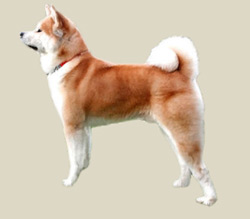
Country of Origin: Japan
Group: Spitz and Primitive types
Section: Asian Spitz and related breeds
Original Function:
Todays Function: security
Dimension Male: 67 cm
Dimension Female: 61 cm
Weight Male: 34-54 kg
Weight Female: 34-50 kg
Litter Size: 3-12 puppies, average 8
Life span: 10-12 years
Other Names: Akita Inu, Japanese Akita
Colors: The japanese akita has only four different colors and they are brindle, white, sesame i.e. hair that
Living: Akitas are very adaptable dogs and can adjust to different living conditions provided they are given
Recognized: ACA, FCI, AKC, UKC, KCGB, CKC, NKC, NZKC, CKC, APRI, ACR, ACA
Description
The largest of the Japanese Spitz-type breeds, the Akita, pronounced a-KEE-ta, is a powerful, solid, well-proportioned and distinctive looking dog. Strong and muscular with a flat, heavy head and strong, short muzzle. The Akita is slightly longer than he is tall with a broad, deep chest and level back. The head is broad and shaped like a blunt triangle. The stop is well-defined and there is a shallow groove going up the center of the forehead. The small, erect ears are carried forward and in line with the neck. The small, triangular eyes are dark brown. The nose is generally black brown is permitted on white Akita"s, but black is preferred,; the lips are black and the tongue is pink. The teeth should meet in a scissors, or level bite scissors is preferred by most breeders,. The tail is carried high and curled over the back. The Akita has webbed, cat-like feet - which makes it a fine swimmer. The double coat is composed of a harsh, waterproof outer coat insulated with a thick, soft undercoat. Coat colors are pure white, red, sesame and brindle. The colors should be without clear borders. A black mask is forbidden.
Temperament
As befitting its spitz-like heritage, the Akita is bold, independent, stubborn and tenacious. Demonstrative to its family, it is utterly devoted and will protect family members. It is reserved with strangers and can be aggressive toward other dogs. It can be domineering. Though not the breed for everyone, in the right hands the Akita is an excellent companion.
Excercise
The Akita appreciates mental and physical exercise every day. It needs the chance to run in a safe area or on leash for a long jog. Given ample exercise and training, it can be a quiet and well-mannered house dog. The Akita is able to live outdoors in temperate or cool climates, but it is happiest if it can spend most of its time with its family. The coat needs brushing about once a week to remove dead hair, more often when shedding. Akitas tend to be somewhat messy drinkers!
Grooming
The coarse, stiff, short-haired coat needs significant grooming. Brush with a firm bristle brush, and bathe only when absolutely necessary as bathing removes the natural waterproofing of the coat. This breed sheds heavily twice a year.
Health
Major concerns: CHD, PRA
Minor concerns: elbow dysplasia, pemphigus, sebaceous adenitis, gastric torsion
Occasionally seen: PRA, patellar luxation, VKH-like syndrome, entropion, epilepsy, cataracts, polyneuropathy, renal cortical hypoplasia
Suggested tests: hip, elbow, eye
Note: Onions have been documented to cause changes in th

